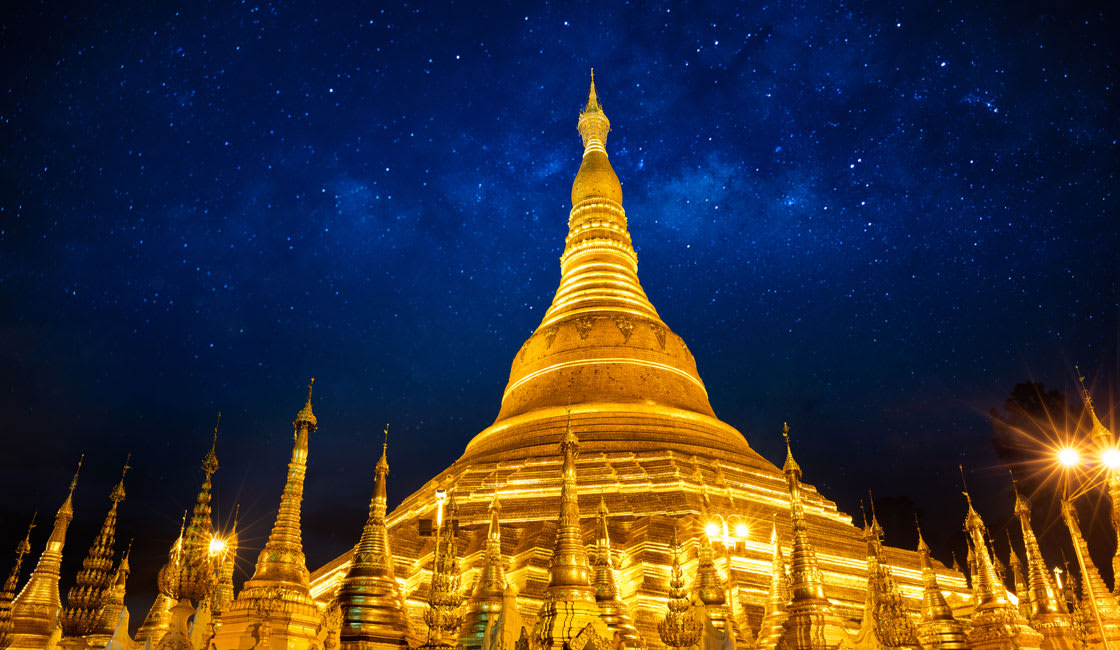
Still cloaked in a thick veil of mystery, Myanmar is Southeast Asia’s latest addition to the global travel scene. With stunning temples, bustling markets, breath-taking scenery and so much more on offer, it is little wonder why so many of us are packing our bags and heading for this new destination. Yet, with so much on offer it is hard to decide where we should spend our precious holiday time. There are a million wonderful things to see and do in Myanmar but your holiday simply wouldn’t be complete without taking the time to check out the fascinating historical site that is the Shwedagon Pagoda. Read on for a brief history of Shwedagon Pagoda.
Located in Yangon, the spectacular Shwedagon Pagoda is believed by Buddhists to be around 2,500 years old and is the most sacred site for the Buddhist population of Myanmar. Not only is the structure said to be the oldest Buddhist stupa in the world but it also contains various relics of Gautama Buddha and previous buddhas – including strands of their hair. With this kind of reputation, it is little wonder so many Burmese Buddhists make their pilgrimage to the Shwedagon Pagoda.
The first thing travelers will notice about this remarkable building is how brilliant and intricate it is. Covered in gold plate and decorated with over 4000 diamonds at the top, the pagoda is guaranteed to be one of the most beautiful things you have ever laid eyes on. But this glimmering outside is just the beginning of what you will find here. Within the pagoda are numerous temples, statues and other stupas, all of which have formed a microcosm of life within the pagoda. Serenity prevails here despite the throngs of people who have come here to pray, worship, meditate or simply just gaze in awe at the beauty of the pagoda and its temples.

Shwedagon Pagoda dominates the city
According to legend, the Stupa was built after two merchant brothers encountered Buddha and were given eight of his hairs as a gift. They returned to their home, Okkalapa, and consulted with the King as to what should be done with the sacred hairs. The King knew that certain objects belonging to previous Buddhas had been buried somewhere on Singuttara Hill. He searched endlessly to find these relics and eventually came across them. Here he decided to build what is now known as the Shwedagon Pagoda, in order to enshrine all of the Buddha’s relics in one place. Of course, this is just a legend – it is up to you to decide what you believe as you wander through the ancient halls of this religious site.
The legend of the Shwedagon Pagoda and what many archaeologists believe based on the evidence that has been unearthed at the site differ somewhat. Experts believe that the pagoda was built sometime between the 6th and 10th centuries, although they cannot be sure. This uncertainty adds an extra layer of mystery to the already mystical site. If you are taking a trip to Myanmar for a spiritual or religious reason then this pagoda is an excellent addition to your Irrawaddy cruise itinerary. Simply being here is enough to feel the ancient power that has been bestowed upon the site over the course of the past centuries.
From 1485 onwards the pagoda has a much clearer history. 1485 is the date that is inscribed at the top of one of the stairways, accompanied by stories of Shwedagon Pagoda. Not long before this, the tradition of gilding the stupas came into play. A queen who wanted to see the pagoda look as glorious as possible donated her own bodyweight in gold to assist in the plating of the building. Later on, the pagoda received yet more donations of gold. Since this time, the pagoda has been rebuilt and refurbished numerous times – the last major rebuild took place in 1789 under the command of King Hsinbyushin. The turbulent past of the Shwedagon Pagoda has seen it be pillaged by British Troops; used as a venue for political activity as Myanmar fought for independence in the 1930s; and damaged repeatedly by various earthquakes. Yet, despite everything, this incredible complex still stands proudly as it looks out over the city.
Understanding the history of an important religious site such as the Shwedagon Pagoda can greatly improve your visit as it provides context to what you are seeing. Let your knowledge of the site transport you back to when the pagoda was in its fledgling years and immerse yourself in its mystical beauty. If you were thinking of traveling to Myanmar but were still on the fence about it, the Shwedagon Pagoda alone should be enough to convince you to take the plunge.
While Rainforest Cruises aim to provide accurate and up-to-date information, we make no representations as to the accuracy or completeness of any information herein or found by following any link on this site. Rainforest Cruises cannot and will not accept responsibility for any omissions or inaccuracies, or for any consequences arising therefrom, including any losses, injuries, or damages resulting from the display or use of this information.




